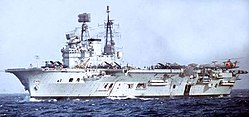History
In 1967 the Home and Mediterranean Fleets were merged to form the Western Fleet. [1] The amalgamated fleet was now responsible for United Kingdom home waters, the North and South Atlantic, and the Mediterranean – all Royal Navy operations “West of Suez”. One of the fleet commander's subordinates was Flag Officer Flotillas, Western Fleet, which Vice Admiral Andrew Lewis filled in 1968–69. [2]
Some details of squadrons in the Western Fleet from 1967 to 1971 can be seen in Graham Watson's work. [3]
In July 1969 fourteen ships of the Western Fleet took part in a Fleet Review and Queen's Colour presentation aboard HMS Eagle in Torbay. The review was challenging due to very inclement weather conditions, with some ships having to sail from Torbay during the night and hundreds of sailors being stranded ashore overnight as it was too rough for small boat transfer.
The headquarters of the Western Fleet was at the Northwood Headquarters in Middlesex. The post of Commander in Chief Western Fleet (abbreviated CINC WF) came with the additional NATO responsibility as Commander in Chief Allied Command Channel. The first Allied Commander-in-Chief Channel was Admiral Sir Arthur Power who was also Commander-in-Chief, Portsmouth, appointed in February 1952. In 1966 it was agreed that the same commander, the Royal Navy's Commander-in-Chief, Western Fleet, should direct the NATO Channel and Eastern Atlantic Commands. [4] As a consequence these functions were combined at his Headquarters in Northwood.
The fleet's existence was quite short in comparison to other fleets of the Royal Navy. The Western Fleet was amalgamated with the Far East Fleet in 1971, and the admiral commanding all the Royal Navy's worldwide forces at Northwood was given the title Commander-in-Chief Fleet (CINCFLEET).
This page is based on this
Wikipedia article Text is available under the
CC BY-SA 4.0 license; additional terms may apply.
Images, videos and audio are available under their respective licenses.
